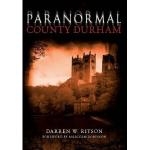
Paranormal County Durham
Veteran researcher Malcolm Robinson contributes a foreword to Paranormal County Durham. He stresses the need to rely on one’s own intelligence when investigating, being prepared to do hard work finding explanations rather than blindly trusting to instrumentation and assuming a paranormal explanation as the default, a welcome corrective to much current ghost hunting wisdom (or rather lack of).
Similarly Ritson in his introduction points out that this field is complex, something that needs to be remembered when television shows make it look easy, and that not having preconceived ideas (which applies to sceptics as much as to those who tend to a paranormal explanation) is an essential prerequisite if an investigation is going to be worthwhile.
The book is divided into nearly three dozen chapters of varying length, most on a separate location, with one devoted to miscellaneous ‘Phantom horses and ghost riders’. There is the usual selection to be found in this type of book, pubs, castles, mansions, but less usual are a former MOD depot, an old POW camp, a lead mine and that annoying song about the grandfather clock that stopped, never to go again, when the old man died, which surprisingly has its origins in a real clock (though not necessarily a real story) at the George Hotel, Piercebridge. It concludes with a series of stories culled from the website of local historian C. J. Linton, who has also researched the paranormal in the area.
County Durham is, as Ritson points out, an area of outstanding beauty, and his enthusiasm for it shines through this survey of its haunted landscape. It is one entry in a growing literature on the paranormal aspects of this area: in addition to coverage in general national gazetteers, there is Ritson’s own Haunted Durham (The History Press, 2010), while Rob Kirkup has produced Ghostly County Durham (The History Press, 2010).
Haunted Carlisle
Demonstrating his continuing ability to get interesting people to pen his forewords, on this occasion Ritson has snagged Paul Adams, well known as an authority on Harry Price, in particular as co-author of The Borley Rectory Companion. For this volume, Ritson has moved away from his usual stamping-ground of the North-East (he is a Newcastle-upon-Tyne native) to examine the historic city of Carlisle, steeped in history and character.
Unsurprisingly slimmer than the one devoted to County Durham, the book is divided into only two sections, one on ghosts in Carlisle itself, and one (much shorter) on the outskirts. This lack of detail wouldn’t be a problem if there were an index, but a lack of any listings makes the book difficult to use as a guide to the area
In addition to the usual mix of folkloric and older accounts (including black dogs) there are some recent cases which involved named individuals. An alleged poltergeist caused problems for a family in 2007, and made the pages of the Daily Mail. It exhibited similarities with the well-known South Shields case with which Ritson was associated. Chapters on the railway station (where I myself once experienced an odd coincidence, my young daughter bumping into her best friend from school, a long way from home) and on Laser Quest detail the author’s personal investigations.
A 2010 story about an apparent ghost caught on CCTV in an off-licence, was covered extensively by international media. At first sight it does appear to be an insect close to the lens, a common occurrence in these situations, but Ritson notes that there were reports of a variety of other phenomena occurring in the shop, so there may be more going on than the CCTV images alone suggest. And of course no book on paranormal Carlisle would be complete without a reference to its famous (or rather infamous) Cursing Stone!
There are overlaps with some other recent gazetteers, notably Geoff Holder’s Paranormal Cumbria (The History Press, 2010), H. C. Ivison’sSupernatural Cumbria (Amberley Publishing, 2010) and Kirkup’s Ghostly Cumbria (The History Press, 2011). Ritson’s Supernatural North(Amberley Publishing, 2009) has a few pages on both County Durham and Carlisle. However, while Carlisle has been included in a number of books covering a wider geographical area, some of which are mentioned in the bibliography, surprisingly this is the first devoted entirely to the city.
Both Paranormal County Durham and Haunted Carlisle are nicely illustrated. One thing did amuse me though. Each features a line drawing of a monk that is identical, though in one he is in company with a group of brothers, while in the other he is on his own. In County Durham we are told that it is an artist’s representation of the monks who are said to walk the grounds of Lumley Castle, in Carlisle it is an artist’s representation of the monk who haunts Carlisle Cathedral. Well, one monk looks much like another I suppose.

